In an atmosphere of secrecy. Tests of the Burevestnik cruise missile
In 2018, for the first time, they talked about a promising domestic cruise missile of unlimited range, later called the Burevestnik. By the time the information was disclosed, the project had reached flight tests, and in the future, new launches were repeatedly carried out. Reportedly, the next such event may take place in the very near future.
Russian news
The "premiere" of the future "Burevestnik" took place on March 1, 2018 as part of a speech by Russian President Vladimir Putin. The head of state revealed the very fact of the existence of a new rocket, and footage of flight tests was also shown. Later, foreign media, citing intelligence sources, indicated that the flights had been carried out since the fall of 2017.
In mid-July 2018, the Ministry of Defense showed the workshop in which experienced "Petrel" are assembled. In addition, it announced the imminent conduct of new flight tests. but news the implementation of these plans was never received. Probably, the next flights of experimental missiles took place, but they did not talk about them.
Subsequently, the Burevestnik project was repeatedly mentioned by officials in the context of the modernization of the army and the creation of new types of weapons. It was argued that work on the new missile continues, and in the future it will go into service. At the same time, no details of the tests were given, and the timing of setting on duty was not named.
However, the domestic media several times published interesting information received from unnamed representatives of the defense industry and the military department. For example, in February 2019, it was reported about the successful completion of tests of a nuclear power plant for the Burevestnik. There was also news about the possibility of adopting the missile into service by 2025.
According to foreign intelligence
Promising Russian projects naturally attract the attention of foreign armies, intelligence services and the media. This leads to very interesting results: most of the reports on the tests of the "Petrel" to date came precisely from abroad. News of this kind is published with reference to intelligence data or reports from analytical organizations.
So, back in the summer of 2018, the American TV channel CNBC learned from its sources in the US intelligence agencies that flight tests of the Russian missile had been carried out since November 2017. Before the official disclosure of information in March, they managed to carry out several launches. At the same time, not all were successful: one of the missiles sank in the Barents Sea, and the military had to organize an operation to lift it.
In February 2019, new publications appeared in foreign media about the next stage of testing the Russian missile. According to some of them, at that time it was already about the 12th or 13th flight. At the same time, it was argued that only one test launch was successful during all the time.
It is curious that a few months later, in September 2019, other information arrived. Again, citing intelligence, the American press claimed that at least five unsuccessful launches took place during the tests. Against the background of the previous news about one success in a dozen launches, such a message sounded extremely interesting - and cast a shadow on all published information allegedly received from intelligence organizations.
A real wave of publications about the "Petrel" took place in August-September 2019, the reason for it was the accident at the Nyonoksa test site. An explosion occurred there, as a result of which several people were killed and injured. In addition, an increase in the radiation background was noted in the nearest regions. Foreign media, research organizations and even US President Donald Trump have linked this incident to a test program for a new cruise missile.
However, Rosatom soon disclosed the details of the incident. The accident occurred on an experimental liquid propulsion system with a radioisotope power source. The connection of this product with the Burevestnik was not reported. Moreover, these projects are unlikely to be related to each other: as far as we know, the rocket is equipped with an air-jet engine.
Since the fall of 2019, news about the tests of the Petrel has not appeared in foreign media. However, interest in this project did not disappear, as a result of which various articles were regularly published on the possible timing and features of the deployment of such weapons, its role in military-political processes, etc.
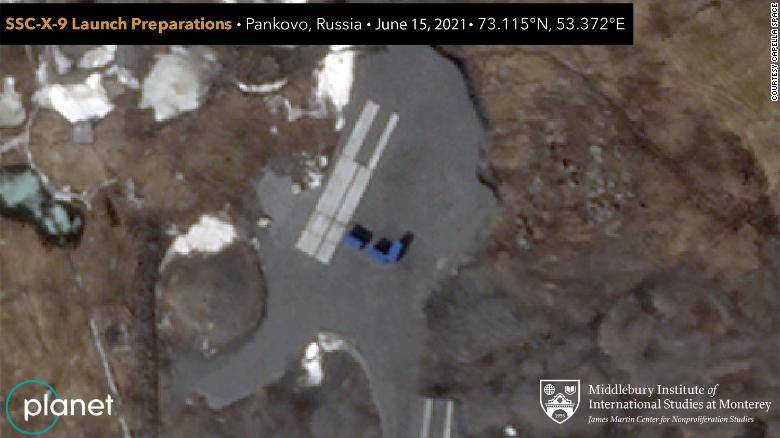
A recent snapshot of the Pankovo landfill. Photo Planet / Middlebury Institute of International Studies Center
New challenges
Whether the promising rocket has been tested since the fall of 2019 is unknown. But now it is reported that the next launch is imminent. As expected, information about this appeared in the foreign press, and the Russian Ministry of Defense has not yet commented on it.
On August 19, CNN reported on the possible continuation of the tests. The reason for this news was satellite images of the Pankovo test site on Novaya Zemlya, taken on August 16 by Capella Space. In addition, additional data was provided by the Middlebury Institute of International Studies Center, which has satellite images from the operator Planet.
Photographs and radars show that until recently, one of the launch sites housed a light shelter that protected personnel and equipment from the elements. Now it has been removed, and, presumably, the launcher and various equipment remained on the site. Some of these objects were missing from the previous photographs.
As circumstantial evidence of preparations for the launch, a recent notification from the Ministry of Defense is cited. In accordance with it, from 15 to 20 August, one of the water areas near Novaya Zemlya near the landfill is closed for navigation.
If foreign journalists and analysts are right, news about the next launch of Burevestnik should appear in the very near future. It is very likely that such reports will reappear in foreign media, while the Russian military department will remain silent.
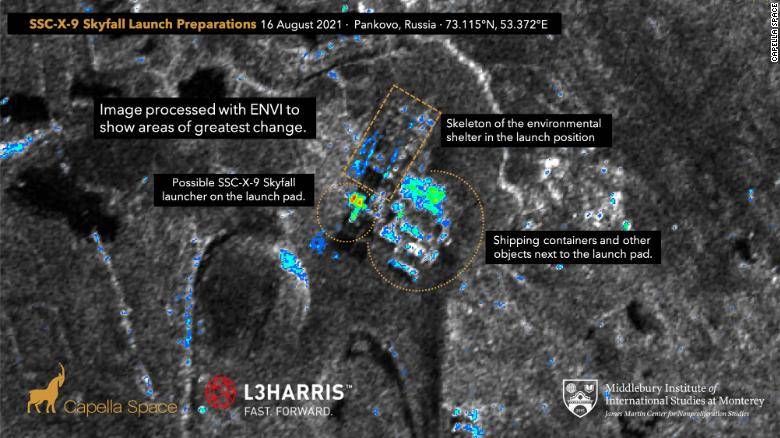
Snapshot dated August 16. Photo by CNN / Capella Space
In an atmosphere of secrecy
In general, the current situation around the Burevestnik project is simple and understandable, although not all the details are known. So, it is clear that the promising rocket entered flight tests four years ago and remains at this stage for now. The production of pilot batches of missiles has been established, and launches are also carried out regularly. Apparently, there should be both successful and unsuccessful flights.
From foreign reports of unclear reliability, it follows that by now at least 10-12 launches have been performed, and at least half have been successful. In addition, right now the next start is being prepared, which, most likely, will have to confirm the correctness of the design decisions in general and the latest fine-tuning measures.
It is to be expected that our Ministry of Defense will again not disclose the fact of the test launch and its results. However, this circumstance will not in any way affect the course of the project. The works will continue and give the desired results, regardless of their coverage in the open press. Moreover, such secrecy also has positive aspects.
Thus, there is no doubt that work on the "Petrel" continues and gives a certain result, although the military and industry are in no hurry to announce all their successes. However, in a few years they will be able to please the public with news of the completion of development, the launch of a series and the introduction of a new rocket into service. And such a "surprise" will justify all the costs of secrecy and a long wait.
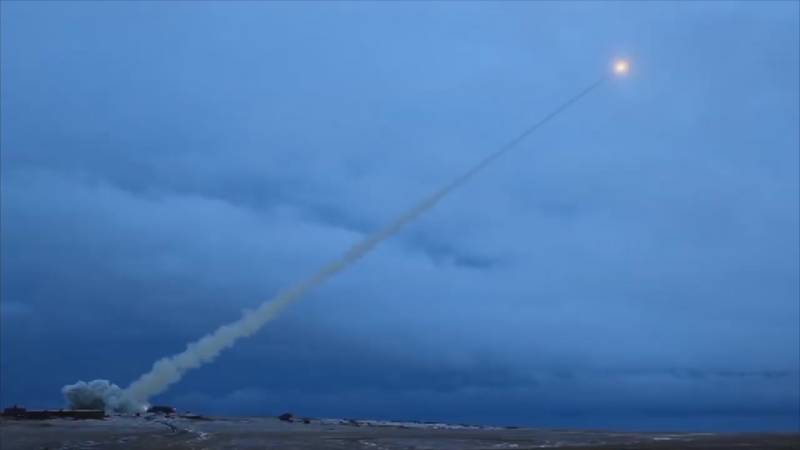
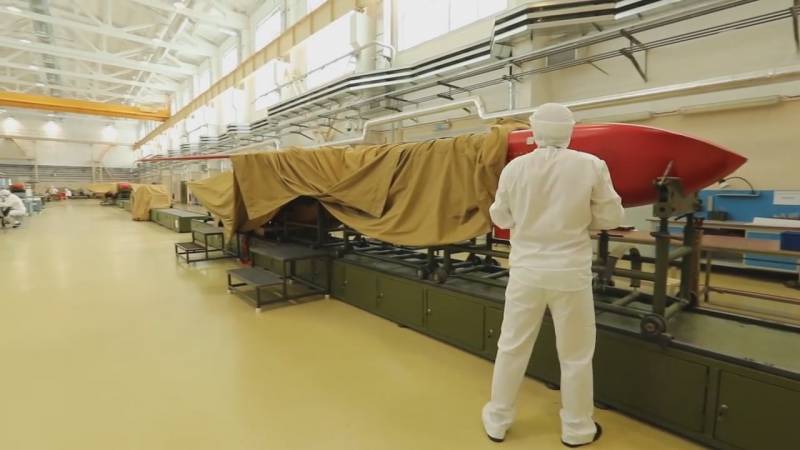
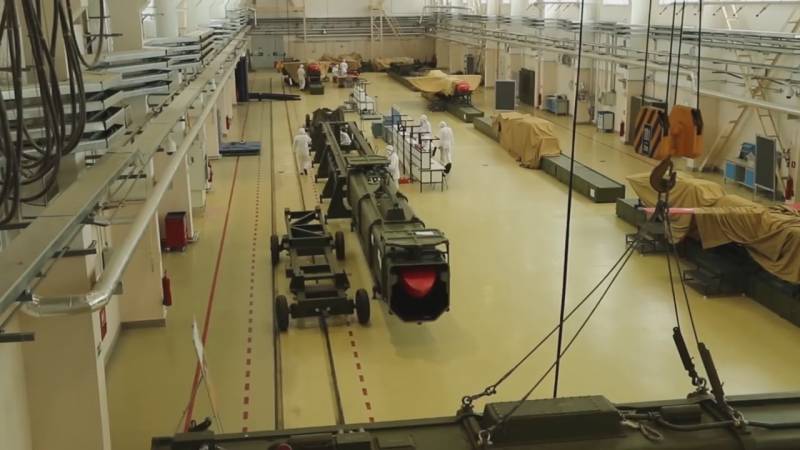
Information